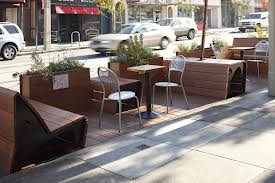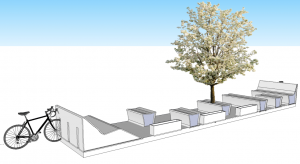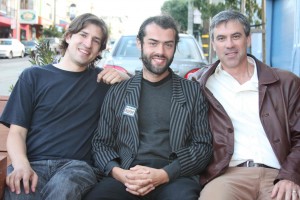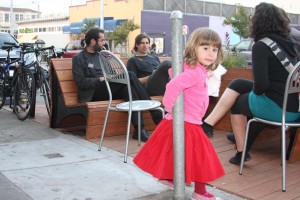 |
Project Basics | |
| Goal: | To build community and support local businesses by providing conveniently situated seating and gathering space. | |
| Years active: | 2010-11 | |
| Website: | The parklet program: http://pavementtoparks.sfplanning.org/parklets.html | |
What We’ve Learned
|
Project team: | Adam Greenfield, Jack Verdon, Caleb Haley |
| Contact: | The 9th Avenue parklet: adam@inner-sunset.org; 415-731-1139 (Adam Greenfield); the City parklet administrators: sfpavementtoparks@sfgov.org | |
| ISPN involvement: | General advice. | |
| Get involved: | This project is complete. | |
The Full Story
by Adam Greenfield, co-organizer
A parklet is defined as “a temporary sidewalk extension”. Basically, a seating area on the same level of the sidewalk is installed on 1-3 parking spaces. The parklet, although usually intended to survive for a long time, must be able to be removed if the project is unsuccessful (eg. if the permit holder isn’t following particular rules, etc). Also, the parklet must clearly be public space – a sign saying that must be installed and there must be no indication that anybody “owns” the space or that only particular kinds of people can go there (eg. customers).

My history with parklets goes back a few years when I’d participate in the annual Park(ing) Day, an annual day where people around the world take over parking spaces and convert them to gathering places. There is no enforced reason for this, but most people do it to raise awareness that public space can be for gathering, not just facilitating the movement and storage of automobiles. A few years ago, the City of San Francisco decided to put an official stamp on the idea of turning parking spaces into gathering spaces by creating the parklet program.

During the second round of applications, I decided it would be great to have one in the Inner Sunset. Local architect and resident Jack Verdon recommended outside local cooperative bakery Arizmendi on 9th Avenue because of the high concentration of people often standing outside the bakery and lacking seating. I’d initially thought Park Chow would be great but quickly saw Jack’s wisdom on this point. Jack offered to design the parklet for free, which I was not expecting him to offer; however, Jack was excited to make something great happen in the neighborhood and was happy to provide his skills pro bono. Luckily Arizmendi was excited too. The team was completed by Caleb Haley, a local Craigslist employee who I liked and whom I thought would be a good person to have on the team because of his strong spatial sensibilities.
All of us, Arizmendi included, were adamant that the parklet be clearly public space and not somewhere people felt they can only sit if they bought something from the bakery.
Jack produced a nice design that we all liked and I started going door to door to let businesses and residents know about the idea and to get their support. Unfortunately, as a support-gathering rookie, I did miss a couple of obvious residents, businesses, and landlords. Looking back, I could have been more thorough in that regard.
However, generally folks were supportive. There was also some opposition and trepidation from some, based on the familiar fears of homeless encampments and loss of parking. Although I pointed out that parklets in other areas of San Francisco had been successful, this didn’t sway opponents; I realized that fear is not often soothed by facts – people need to see the thing working, to have it demystified in the flesh.
From submitting our application in October 2010 it took almost a year until the parklet was finally installed in September 2011. Unfortunately, one nearby resident was very against the proposal and did his best to delay as much as possible. We were forced to collect hundreds of signatures and attend subsequent hearings months later. However, the strength of support was so great that it was only a matter of time until success.
 We were lucky with our team member selection. There was me, who as a volunteer, had plenty of available time to work on this project. Jack generously designed the parklet for free. And perhaps the biggest surprise that hadn’t dawned on me in advance was that Caleb could donate to the project and have his donation matched several times over by his employer Craigslist. So we were funded too. Very fortunate. I’m really grateful to Jack and to Caleb whose amazing generosity made this a reality.
We were lucky with our team member selection. There was me, who as a volunteer, had plenty of available time to work on this project. Jack generously designed the parklet for free. And perhaps the biggest surprise that hadn’t dawned on me in advance was that Caleb could donate to the project and have his donation matched several times over by his employer Craigslist. So we were funded too. Very fortunate. I’m really grateful to Jack and to Caleb whose amazing generosity made this a reality.
As or writing, the parklet has been in for over a year and has been every bit the success we hoped. Especially on Sundays when the farmers’ market is going, the parklet can get quite full and is a lively sight. And there has been little or no sign of antisocial behavior. The parklet has definitely livened up the area. We are very happy with how it’s turned out.
At the same time, the parklet has its limitations and ones upon which we should reflect. Although the parklet is a nice spot, it is just two reconfigured parking spaces on an otherwise busy automobile road; a far cry from the plazas and promenades enjoyed by Europeans, Latin Americans, and other countries worldwide. We need bigger and better spaces that take up the whole street and so I hope the parklet program will be one day seen as a small but important step toward that reality.
